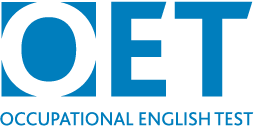Occupational English Test
Occupational English Test (OET) is an international English language test that assesses the language communication skills of healthcare professionals who seek to register and practise in an English-speaking environment. OET is available for 12 professions, including medicine, nursing, dentistry, pharmacy, physiotherapy, veterinary science, occupational therapy, speech pathology, dietetics, podiatry, radiography, and optometry.
History[edit | edit source]
The Occupational English Test was developed in the late 1980s by Professor Tim McNamara, under the auspices of the Australian National Office for Overseas Skills Recognition (NOOSR), which is now part of the Department of Education, Skills and Employment (DESE). The aim was to create a test that would provide a valid and reliable assessment of the English language proficiency of healthcare professionals. Since its inception, OET has undergone several revisions to ensure it remains relevant to the current healthcare industry and its language requirements.
Format[edit | edit source]
OET covers all four language skills with an emphasis on communication in a healthcare environment. The test consists of four components:
- Listening (approximately 45 minutes) - divided into three parts, designed to assess the ability to follow and understand a range of health-related spoken materials such as patient consultations and lectures.
- Reading (60 minutes) - divided into two parts, testing the ability to read and understand different types of text on health-related subjects.
- Writing (45 minutes) - consists of one task specific to the profession, based on typical workplace situations.
- Speaking (approximately 20 minutes) - also profession-specific, involves two role-plays in which the test-taker assumes their professional role and interacts with a patient or client.
Recognition[edit | edit source]
OET is recognized by regulatory healthcare bodies and councils in various countries including Australia, New Zealand, United Kingdom, Ireland, Dubai, Singapore, and others. It is also accepted by universities and a wide range of healthcare employers as proof of English proficiency for registration, study, and work in the healthcare sector.
Preparation and Registration[edit | edit source]
Candidates can prepare for OET by accessing a range of materials and courses provided by the OET Centre and accredited preparation providers. Registration for the test can be done through the official OET website, where candidates can choose their profession, select a test date, and find a test venue near them.
Benefits[edit | edit source]
For healthcare professionals, passing OET demonstrates they have the necessary language skills to communicate effectively in a healthcare environment, ensuring safe and high-quality patient care. For employers and regulatory bodies, it provides assurance that the healthcare professionals they register or employ can communicate effectively, which is critical for patient safety and care.
Navigation: Wellness - Encyclopedia - Health topics - Disease Index - Drugs - World Directory - Gray's Anatomy - Keto diet - Recipes
Search WikiMD
Ad.Tired of being Overweight? Try W8MD's physician weight loss program.
Semaglutide (Ozempic / Wegovy and Tirzepatide (Mounjaro / Zepbound) available.
Advertise on WikiMD
WikiMD is not a substitute for professional medical advice. See full disclaimer.
Credits:Most images are courtesy of Wikimedia commons, and templates Wikipedia, licensed under CC BY SA or similar.Contributors: Prab R. Tumpati, MD

